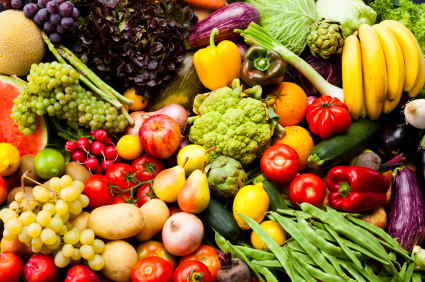


Fruits and Vegetables
Fresh, filling and heart-healthy, fruits and vegetables are an important part of your overall healthy eating plan. They are high in vitamins, minerals and fiber and low in fat and calories. Eating a variety of fruits and vegetables may help you control your weight and your blood pressure.
Mom was right; eat your peas and carrots (and grapes and oranges).
The American Heart Association recommends eating eight or more fruit and vegetable servings every day. An average adult consuming 2,000 calories daily should aim for 4.5 cups of fruits and vegetables a day. Also, variety matters, so try a wide range of fruits and veggies.
When added sugars and sodium hide, you must seek:
Any product that contains fruit has some natural sugars. However, sugars are often added to packaged or prepared fruit and may be disguised as many different names on the list of ingredients. The line for “sugars,” as you see on a Nutrition Facts panel, includes both added and naturally occurring sugars. Learn more about sugars.
Sodium is also often added to canned or frozen vegetables. Check the amount on the Nutrition Facts panel (link to the Reading Food Labels page) and choose reduced or sodium-free products. Limiting sodium can help you reduce the risk for heart disease. Learn more about sodium.
Tips to boost fruits and vegetables to your diet
- Keep it colorful. Challenge yourself to try fruits and vegetables of different colors. Make it a red/green/orange day (apple, lettuce, carrot), or see if you can consume a rainbow of fruits and vegetables during the week.
- Add it on. Add fruit and vegetables to foods you love. Try adding frozen peas to mac’n’cheese, veggies on top of pizza and slices of fruit on top of breakfast cereals or low-fat ice cream.
- Mix them up. Add fruits and vegetables to food that’s cooked or baked, or mix vegetables in with pasta sauces, lasagnas, casseroles, soups and omelets. Mixing fresh or frozen berries into pancakes, waffles or muffins is another great way to make fruits and veggies a part of every meal.
- Roast away. Try roasting vegetables like cauliflower, broccoli, Brussels sprouts, onions, carrots, tomatoes or eggplant. Long exposure to high heat will cause these foods to caramelize, which enhances their natural sweetness and reduces bitterness.
- Use healthier cooking methods. Steaming, grilling, sautéing, roasting, baking and microwaving vegetables are ideal preparation methods. Use fats and oils low in saturated fats sparingly; don’t use trans fats.
- Enjoy vegetable dippers. Chop raw vegetables into bite-sized pieces. Try bell peppers, carrots, cucumbers, broccoli, cauliflower and celery, and dip your favorites into low-fat or fat-free dressings. Dip tip: Read the food label of sauces and dressings to make sure they are not overloaded with saturated fat and salt.
- Sip smoothies. Smoothies are a great way to increase the amount of fruit you eat and they’re really easy to make. A basic smoothie is just frozen fruit, some low-fat or non-fat milk and/or yogurt, and 100% fruit juice all processed together in a blender until smooth. Experiment with different fruits to find out what you really like. Note that some cholesterol-lowering medications may interact with grapefruit, grapefruit juice, pomegranate and pomegranate juice. Please talk to your health care provider about any potential risks.
- Try fruit pops. Put 100% fruit juice in an ice tray and freeze it overnight. You can eat the fruit cubes as mini-popsicles or put them in other juices. Frozen seedless grapes make natural mini-popsicles and are a great summer treat.
- Enjoy fruit desserts. Fresh or canned fruit in light syrup or natural fruit juice, gelatin containing fruit and dried fruit are good choices for a dessert.
